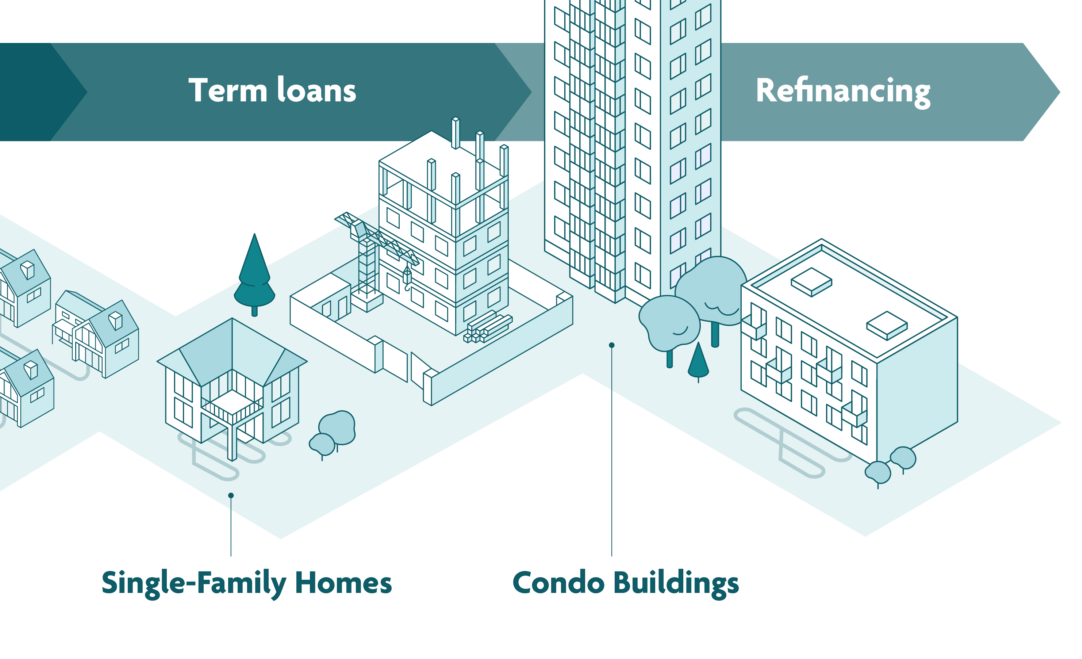September 12, 2024, Traditional territory of multiple Indigenous nations, including the Haudenosaunee and the treaty territory of the Mississaugas of the Credit/Toronto, ON – Vancity Community Investment Bank (“VCIB”), Subterra Renewables (“Subterra”) and Forum Asset Management (“Forum”) are pleased to announce the closing of a new credit financing partnership that will support the installation of geo-exchange systems at multiple new residential towers in Ontario. This is the second VCIB credit facility in support of Forum and Subterra’s innovative partnership that works to integrate geo-exchange technology into new buildings.
Subterra, a leading low-carbon energy developer, brings its expertise and its Energy As A Service (EAAS) utility business model. EAAS reduces costs and risk by offering residential property developers the opportunity to partner with an experienced geothermal asset manager—utilizing best practices, dedicated resources, and direct experience to unlock the value of a geothermal exchange system. Subterra’s EAAS offering provides several benefits to residential property developers including reduced upfront capital investment, alignment with green building standards for easier certification, potential access to development charge credits, and enhanced eligibility for CMHC-insured loans.
Typically, new residential buildings would be served by traditional, carbon-intensive HVAC systems. Instead, geo-exchange heating and cooling systems will be installed, avoiding carbon emissions of up to 8,500 tonnes annually. That equates to taking more than 1,800 cars off the road each year or planting more than 141,000 trees.
Installing energy efficient, low-emission geo-exchange heating and cooling systems in new buildings puts long-term sustainability at the forefront. Unlike deep geothermal energy, which uses fracking methods to access heat deep in the earth’s crust to create electricity, geo-exchange employs much shallower and less intrusive drilling methods to use the earth as a thermal battery, storing heat in the summer and extracting it in the winter. This process creates energy-efficient heating and cooling for buildings and eliminates the need for conventional, fossil fuel-based HVAC equipment.
Partnerships like this one demonstrate how collaboration can drive transformative change. “We’re excited to see geo-exchange gain traction in Canada through this financing partnership. Subterra and Forum’s approach will have a significant impact on the urban carbon footprint, advancing our low-carbon, climate-efficient transition,” said Jennifer Hutcheon, VCIB’s Vice President. “Financing energy efficient, low-emission technology is crucial in the fight against climate change and necessary to make homes more resilient.”
Subterra, and every member of its team, is dedicated to combatting climate change. “With this in mind, we expect our business partners to share our vision and values,” noted Lucie Andlauer, CEO of Subterra. “This is why partnering with VCIB was such an easy decision. VCIB has a long history of positively impacting communities and the climate. Their financing allows Subterra to build renewable and sustainable geothermal heating and cooling solutions for new developments and provides significant value to developers, building owners and tenants, supporting our ethos that making the right choice for the environment does not need to cost more than the status quo.”
“Forum is committed to delivering Extraordinary Outcomes™ to its stakeholders. Our partnership with Subterra and financing relationship with VCIB demonstrate our ability to partner with and drive value for Canada’s leading entrepreneurs,” added Rob Kaplan, Partner at Forum Asset Management. “This investment represents Forum’s third in sustainable infrastructure and HVAC services companies. We are proud of our role in setting a new standard for energy efficiency in Canada.”
About Vancity Community Investment Bank (VCIB)
Vancity Community Investment Bank is an Ontario-based bank and a subsidiary of the Vancity Group. VCIB provides specialized financing solutions for impactful projects like social purpose real estate and clean energy projects. For purpose-driven businesses and organizations, VCIB offers banking, investing, and financing solutions tailor-made to increase their growth and impact. VCIB is a Certified B Corporation and a member of the Global Alliance for Banking on Values.
About Subterra Renewables
Subterra Renewables is a geothermal exchange utility company with access to the largest drilling fleet in North America, operating the most energy-efficient and resilient heating and cooling technology in the world. Subterra is a fully vertically integrated company that custom engineers, installs, owns and operates first-of-its-kind geothermal exchange systems. As a leader in the sustainability and decarbonization movement, its best practices align with government ESG initiatives, expedite building approvals, and accelerate a path to net-zero.
About Forum Asset Management
Forum is a North American investor, developer and asset manager. Our core purpose is to deliver Extraordinary Outcomes™ to our stakeholders. Our adaptable, agile, and dynamic team is committed to sustainability and responsible investing, creating value that benefits the communities in which we invest. Our investment focus includes real estate, private equity, and infrastructure. The enterprise value of our assets under management exceeds C$1.7 billion. We’re proud to have delivered top-tier alternative asset returns since 2002, while positively impacting over 10,600 lives.
Media Relations
Vancity Group
mediarelations@vancity.com
778-837-0394
Subterra Renewables
Victoria Hunt
victoria@subterrarenewables.com





